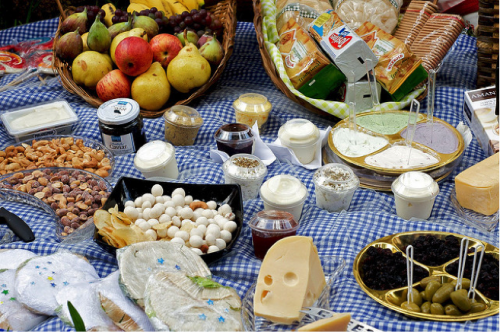Summer is in full swing along with all your favorite outdoor activities. Make way for camping, cookouts, and picnics, oh my! Hmmm… all these activities seem to have two things in common: food and hot weather.

What is a Foodborne Illness?
While you may be trying to soak up all of summer’s precious sunshine and warmth, your food, on the other hand, should not. Foodborne illnesses occur when food is contaminated with disease-causing germs, such as bacteria and viruses. These harmful little critters grow and spread the fastest in food between the temperatures of 41-140°F, commonly referred to as the danger zone. According to the United States Department of Agriculture (USDA), rates of foodborne illnesses (aka food poisoning) increase during the summer months.
Foods that should be served or stored in cooler temperatures (perishable foods) are at the greatest risk for entering the danger zone and potentially causing a foodborne illness. Some examples of perishable foods include:
- Milk, soft cheeses (cream cheese, cottage cheese, mozzarella), yogurt
- Hard cheeses, like Parmesan, can be left at room temperature. However, it is still not safe to leave them in the heat.
- Meat, poultry, fish
- Peeled or cut fruits and veggies
- Pasta salad and potato salad
These cold, perishable foods should always be kept or stored under 40°F (which is why your refrigerator at home is likely set to around 35°F). Following this guideline, perishable food should not sit out for more than two hours. This includes if the food is outdoors on a picnic table or indoors on the kitchen counter as well. In hot weather, perishable food should not sit out for more than one hour.

Here’s what you can do to keep your family, friends, and neighbors safe this summer season while still eating all your favorite foods:
Travel or store food outside with insulated coolers
- Coolers keep warm air out while keeping cold air in. Pack your cooler with perishable foods and bagged ice or frozen gel packs. A full cooler stays colder longer than one that is partially filled. So go ahead, buy that extra block of cheddar cheese for those burgers; it’ll help keep the cooler cold!
- Keep the cooler out of the sun. Cover it with a blanket if traveling in a car, or place it in the shade once at the event.
- Avoid opening the cooler repeatedly. The more the cooler is opened, the more the cold air from within will escape.
- If you’re serving food buffet or family style, serve perishable food in small portions and keep the rest of the dish in the cooler until needed.

Don’t have ice packs? Don’t worry: keep cool creatively!
- Refrigerate or freeze foods the day before so it’s cold when you leave. Still place foods in an insulated cooler, but now your ice pack is also your meal.
- Freeze water bottles for multipurpose ice packs. Not only will these help keep your other foods nice and chilled in the cooler, but they will also encourage healthy hydration.
- And my favorite option is to… use frozen milk cartons! What’s more refreshing than a cold cup of milk on a hot summer day? And it will also help keep other foods cold as well. Nourishing and practical: this trick is a win-win! Milk cartons do thaw faster than frozen water bottles, so plan ahead for longer outings.
Safety for summer camp
- These guidelines also apply when sending your kiddo off to day camp this summer. Pack lunches in an insulated lunch bag (aka a single serve insulated cooler). Most likely the lunch will not be refrigerated and instead may be shoved into a plastic bin or hot cabin for the entire morning. Use a frozen gel-pack, water bottle or milk carton to also keep the lunch nice and chilled. Follow these tips and you’ll be sure to pick up a happy camper at the end of the day!

Summer is a time to enjoy the great outdoors, the great company of friends and family, and all the great food. Practicing these food safety guidelines will only ensure that you get the most out of your summer gatherings!

